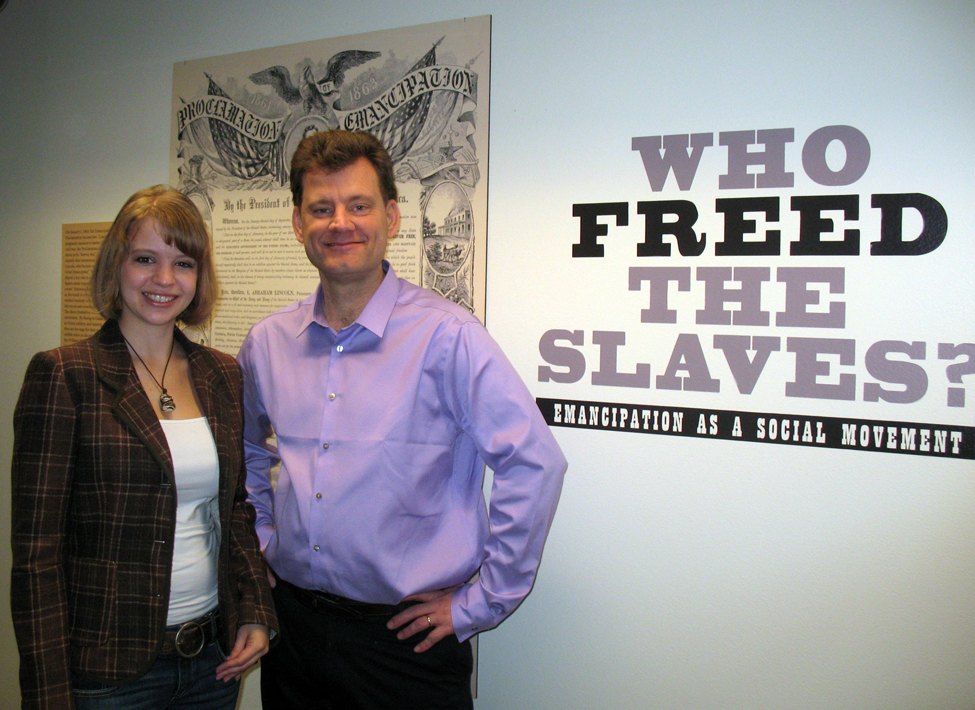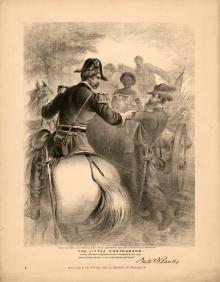
Exhibition at the UCSB Library Commemorates the 150th Anniversary of the Emancipation Proclamation


There is little doubt that the Emancipation Proclamation, which declared freedom for the millions of slaves in the Confederate States, advanced the cause of abolition. Signed by Abraham Lincoln, it became law on January 1, 1863, more than two years before the Civil War ended with General Robert E. Lee's surrender at Appomattox Court House.
"Who Freed the Slaves? Emancipation as a Social Movement," an exhibition in the Department of Special Collections at the UC Santa Barbara Library, highlights the long history behind the Emancipation Proclamation. The exhibition marks the 150th anniversary of this important document, and takes a look at the circumstances under which it was issued, and its impact on those who opposed and supported slavery as an institution.
John Majewski, professor of history at UCSB and co-curator of the exhibition, will give a talk titled "Who Freed the Slaves?" at 4 p.m. on Tuesday, February 12, in the Mary Cheadle Room on the third floor of the UCSB Library. His talk is free and open to the public.
"The title of the exhibition is ‘Who Freed the Slaves?' because we wanted to focus on emancipation as a longstanding social process," said Majewski. "We wanted to develop the full context of emancipation, acknowledging Lincoln as a political leader who guided the country through the Emancipation Proclamation and determined the appropriate time to issue it. But we also wanted to include the abolitionists and other people who put the issue of slavery on the table long before politicians like Lincoln would even touch it."
Among those other people, according to Majewski, were slaves who fled to Union lines and served as Union soldiers, and set the stage for their own liberation. "This is why we ask the question, ‘Who freed the slaves?'" he continued. "In some ways, the slaves freed themselves by running away during the war, resisting slavery, and by volunteering for the Union army and providing the manpower necessary to win the war and allow emancipation to take place."
Added Maria Fedorova, a doctoral student in American history and co-curator of the exhibition: "The point is to show how emancipation is remembered today –– it's mainly the figure of Lincoln, and not the African American soldiers or the abolitionists."
Revered today as one of the country's greatest historical documents, the Emancipation Proclamation did not meet with overwhelming popular approval, even among anti-slavery northerners. "A lot of them distrusted it because it included the caveat that slavery could continue in southern states that chose to rejoin the Union by January 1, 1863," Majewski explained.
According to Majewski, many historians interpret the Emancipation Proclamation as a fairly conservative document. "One of the things we stress in the text is that Lincoln issued the Emancipation Proclamation under his authority as commander-in chief," he said. "Lincoln is arguing that the country is at war, and, as commander-in-chief, he is ending slavery in the South as a way of undermining the rebellion. It's a wartime measure, and that accounts for the lack of grand rhetoric."
The exhibition, which is drawn from the vast holdings of the library's William Wyles Collection, begins with an overview of slavery and its importance to the economy of the South and of the Confederacy. Bills of sale for the purchase of slaves demonstrate their value as property to white southerners, Majewski noted. "The total values of slaves would have been worth $3 billion in 1860, which is more than the value of all factories and railroads in the nation combined," he said. "Historians are overwhelmingly convinced that slavery was the major cause of secession."
Among other items on display are Francis Bicknell Carpenter's portrait of Lincoln and his cabinet at the signing of the Emancipation Proclamation; a program from the Grand Jubilee Concert at Boston Music Hall, which honored the Emancipation Proclamation; copies of Harriet Beecher Stowe's "Uncle Tom's Cabin" and Frederick Douglass's "My Bondage and My Freedom"; a document containing the original text of the Emancipation Proclamation; and the diary of Clara Cheney-Minard, a supporter of abolition.
The exhibition continues through April 30. The Department of Special Collections is open Monday, Thursday, and Friday from 9 a.m. to 5 p.m., and Tuesday and Wednesday from 9 a.m. to 8 p.m.
Related Links



